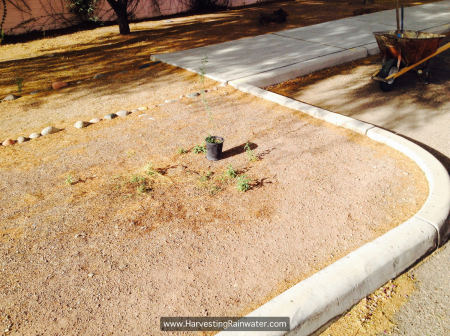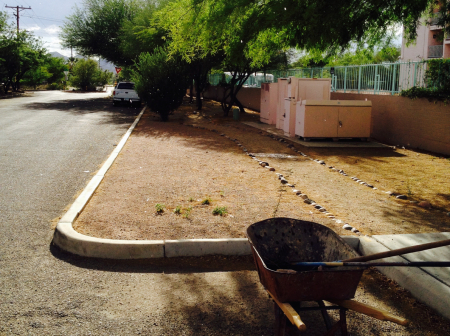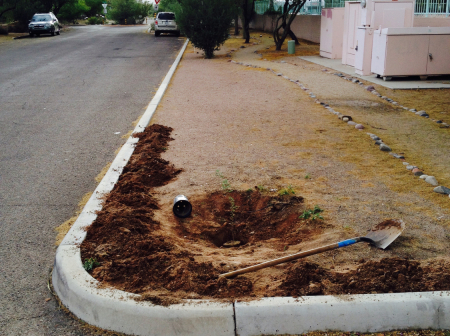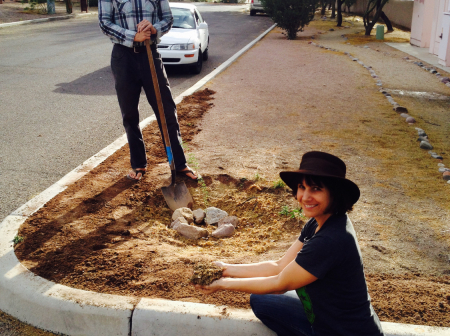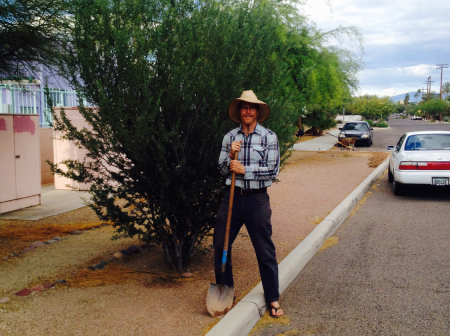Guerrilla-Planting Rain and Native Food Trees
by Brad Lancaster © 2015
www.HarvestingRainwater.com
Yesterday riding my bike home I saw a bare wet spot. A prime planting spot. A potential-life spot. A food spot. A joy spot.
Such a spot can be artificial, the result of imported water, as it was in this case. But even better if it’s natural—due to a natural concentration of precipitation or locally harvested rainwater—as this site soon started to become….
Many years ago an ornamental non-native tree had been planted here, with drip irrigation installed. In less than a year the drought-stressed tree blew over in a strong wind and died, but the irrigation continued to run.
I had planted a food-bearing native tree in its place, and in many other bare spots in the public rights-of-way. Almost all the native trees I planted thrived—thanks to their stronger root systems—but for some reason a landscraping crew took out the young Foothills palo verde tree in this one spot. This weekend it was time to try again.
This time my friend Julie and I planted a one-gallon screwbean mesquite that will in time provide delicious seed pods. My neighbor Sky Jacobs had grown this tree from seed collected from another tree we had planted along his street. But first, we planted rain (in the form of a basin) and fertility (in the form of mulch placed or to be collected in the basin).
As we dug the basin, we expanded its water-harvesting footprint by placing and shaping the dug-out soil to create a slope draining into the basin. If the irrigation system breaks or is shut off, as often happens, the basin will continue to catch rainwater. Additionally, that salt-free rainwater will leech out from the tree’s root zone the salt that is introduced by the city water that comes through the irrigation line. We planted the tree deep enough in the basin so the top of the root ball was level with the elevation of the street. That way, if the tree survives the landscrapers, the basin size could be increased and deepened in the future to accept street runoff via a cut made in the street curb. If that happens, the base of the tree will be at the same elevation as the street at the curb opening. But with the basin enlarged and therefore receiving more rainwater, the tree would happily end up on a terrace (Terrace Rain–Garden Zone), rather than in the lowest point of the basin. Therefore the tree would be neither too high and dry, nor too low and too wet. Of course it would make more sense for the tree, and for the world, to start with the larger basin and the curb cut now. But since those typically maintaining this landscape are not quite ready for that much change that fast, we are starting more gradually here, in a way that still allows for all the enhanced passive street-water harvesting in the future.
Julie collected free organic mulch in the form of dried mesquite blossoms that had gathered up along the street curb. She placed the mulch within the basin where it will add nutrients and increase the rate of the water’s infiltration into the soil while reducing soil moisture lost to evaporation. Due to the recessed, bowl-like shape of the basin, it will now naturally collect its own leaf-drop mulch and that from surrounding trees as the initial mulch Julie applied gradually decomposes and builds more fertile soil.
I put a circle of rocks around the base of the tree to signify that this plant is important. Someone went out of his/her way to ring it with rock. Someone cares, take note!
I’ve found this sometimes reduces the probability that a landscraping crew will weed-whack the young tree before it grows to the unmistakable size and form of a more mature tree. More effective still is to speak with the landscaping crew, land manager, and owner to ensure everyone is on board and looking out for the health of the tree—although sometimes they are not. Sometimes guerrilla planting is worth the chance it will succeed.
I’ve planted dozens of (now-mature) trees guerrilla-style within a two-block radius of my home, and hundreds more with permission.
Guerrilla planted or not, the best time to plant rain, fertility, and trees was 20 years ago… or today. Since 1996, I’ve helped plant over 1,400 trees with my neighbors in our one neighborhood alone. The trees that do best are always those that are coupled with the planting of rain. Food-bearing native trees are the easiest to succeed with, since they have adapted over millennia to our local climate and soil conditions. Done right, you get very productive trees that require no imported water that is extracted and pumped in from elsewhere. Free local rainwater and street runoff as the only water source—invested and infiltrated, not drained or extracted. See my books at www.HarvestingRainwater.com for how.
As a result of all these trees and how they are planted and grow, this is a much more alive, productive, and liveable place than it used to be. More joyous too.
Such planting of trees and rain blisses me out; judging by the many smiling neighbors walking by or chipping in to help yesterday, others seem to get the same reward.
Tonight it’s raining, which means free water is filling the tree’s basin. Rain is being planted. More life is growing, regardless of what may eventually happen to that plastic irrigation line or the salty water that flows through it. Turns out the bulk of our city’s water is pumped over 3,000 feet uphill after being extracted from the dwindling Colorado River over 300 miles away from us. Planting a tree that will forever be dependent upon that imported water contributes to the decline and potential death of that river—and the tree. But the planting of rain instead of a plastic irrigation tube starts to transform this paradigm. Rain planting can enhance the health of that river, as it also directly enhances the health of the community where the tree’s roots are set. Once this tree is established (after one to two years of supplemental watering) the irrigation line can be plugged. Rainwater can be the sole source of water. Add some stormwater from the street and it will not just survive, it will thrive. The resulting shade will bring temperatures down and reduce not just water lost to evaporation, but also our collective sweat and the energy use of air conditioners no longer needed. A more sheltered microclimate will be created in which more life can grow and play. And it will attract still more life. While non-native mesquite trees attract only about a dozen native pollinators, native mesquite trees attract over 60 of these native pollinators—which have co-evolved with these native trees. The native pollinator insects in turn attract more native song birds, which sing to me as I—and they—harvest the delicious seed pods: Life attracting and generating more life.
As the rain falls, and the mulched basin plants the rain, I can’t think of a better blessing or buzz.
Check back for a future post on the even simpler practice of planting tree seed directly within rain basins. I’ll show you how to succeed without any supplemental irrigation—even in a dryland environment like mine.
And check out www.DesertHarvesters.org for upcoming wild native foods events in Tucson in June, and NeighborhoodForesters for planting tips.
See the new, full-color, revised editions of Brad’s award-winning books
– available a deep discount, direct from Brad:

Volume 1


